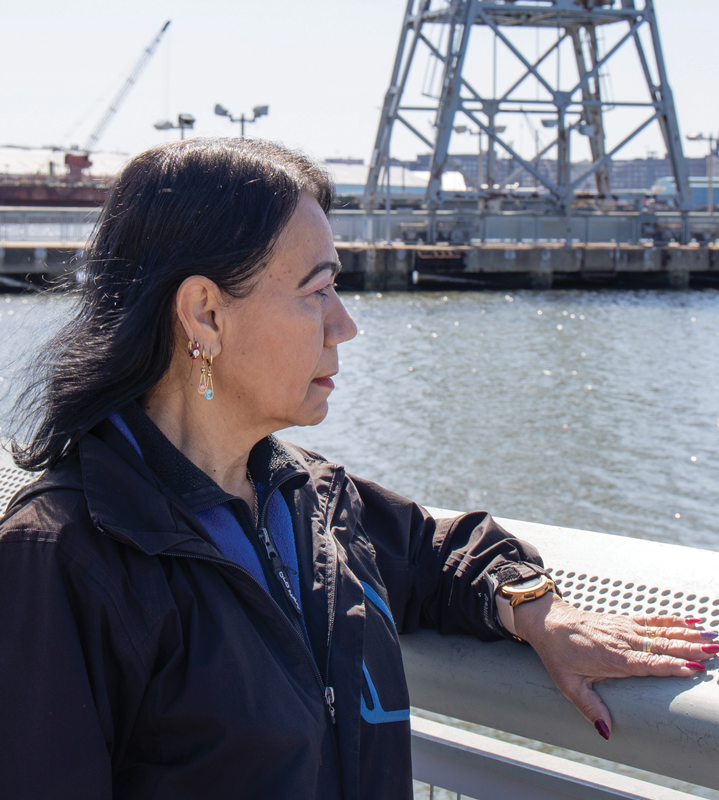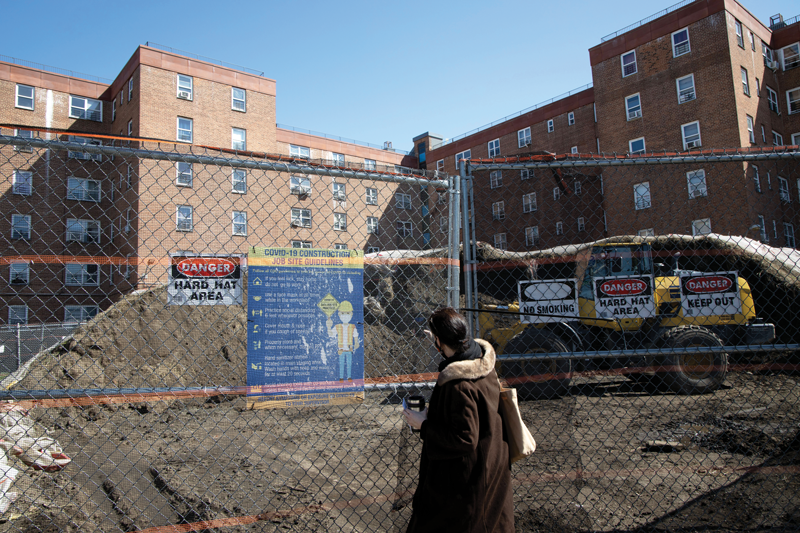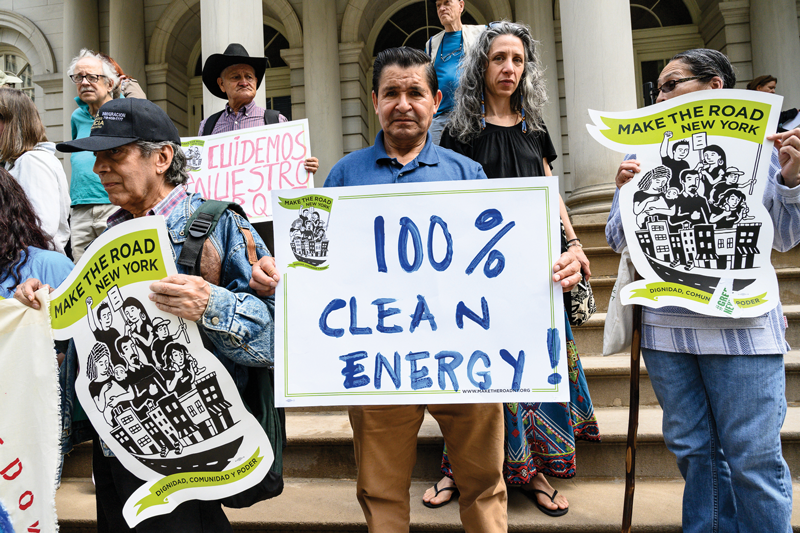An in-depth look at issues important to New Yorkers
Over the 45 years she has lived at the Red Hook Houses in Brooklyn, Juana Narvaez has seen a lot of flooding, but nothing like what happened after superstorm Sandy in 2012.
“There was a lot of destruction,” she said, recalling the muddy floodwaters pushing cars around, wrecking basement boilers, and damaging bodegas and churches. At the nearby Gowanus Houses, more than 2,000 people lost heat and power for more than 10 days. Water poured in from all three sides of the small peninsula, causing sewage overflows and worrying residents that the industrial chemicals buried in the area would get dislodged.
Since that time, Narvaez completed the Trust-supported “Turning the Tide” training by the Fifth Avenue Committee and has become a climate change activist, preparing herself and neighbors for the next catastrophic event, while trying to reduce the likelihood of it happening again.
Sandy caused unprecedented flooding across the region’s coastal areas, killing 44 residents and causing almost $20 billion in damages in New York City, with many saying it was a wake-up call to address climate change and rising sea levels. Then last year, flooding from Hurricane Ida’s rainfall killed more than a dozen New Yorkers trapped in basements in neighborhoods nowhere near the coast. It was a grim realization that human-driven climate change is an increasing threat to all.
“It’s finally dawning on people, what the scope of climate change means for this town,” Eddie Bautista, executive director of the New York City Environmental Justice Alliance, told The New York Times days after Ida.
Most climate experts—97 percent—agree that the rapid global warming we have seen over the past few decades is due to human activity. While some groups continue to deny or discount this threat, the need for collective and individual actions to confront the cascading consequences of inaction is clear.
To address climate change effectively, said Arturo Garcia-Costas, The Trust’s program officer for the environment, “We need public and private sector leadership on clean energy, green transportation, and climate resilience. We need philanthropy to support innovative and sometimes risky solutions. And we need individual action.”
The Trust has supported efforts to mitigate the effects of climate change for decades. Like the work in Red Hook, we have bolstered the region’s preparedness for climate disasters, and funded advocacy campaigns that helped move the city and state to become national models for comprehensive climate action.
Our grantmaking pursues three main strategies both nationally and locally: influencing policies and practices, adapting to the destabilized climate, and reducing emissions of the gases that are trapping solar energy and warming the atmosphere. In addition, we have supported nonprofits that are ensuring that people of color and low-income New Yorkers, like those in Red Hook and Gowanus, participate and benefit fairly from government actions to address the growing crisis.
Much of our environmental grantmaking is made possible by the Henry Phillip Kraft Family Memorial Fund, which was established in The Trust in 1996 by Kraft’s daughter specifically for “environmental protection and improvement, wildlife protection, conservation of natural resources, and the preservation of land, water, and air.” The fund has allowed The Trust to make more than $78 million in grants to effective nonprofits, many of which are addressing climate change.

Strategy 1: Influencing Policies and Practices
Because of the enormous scale of climate change, many of The Trust’s grants are aimed at making progress that can only be realized through big systems change. We support groups urging government to adopt policies to better protect flood-prone neighborhoods, for example, and to make cleaner energy more widely available. And we help nonprofits working with the private sector to reduce the carbon footprint of companies and increase their energy efficiency.
New York State became a global climate change leader with the passage of the Climate Leadership & Community Protection Act in 2019. It puts the state on the path to achieve net-zero greenhouse gas emissions by 2040, with 35 percent of the government’s spending toward this ambitious goal directed to help historically underserved communities. That legislation passed after an advocacy campaign led by the NY Renews Education Fund and Environmental Advocates of New York. To make sure the law fulfills its promise, The Trust is also funding nonprofit efforts to monitor and support its implementation.
For several reasons, climate change often deals its hardest and most lasting blows to low-income communities. Historically, low-lying areas underserved by mass transit were developed for high-density public housing across the city. Similarly, polluting industrial facilities and infrastructure were often sited in areas with little political clout. In fact, the city’s first federal Superfund site was the Gowanus Canal, which was once a busy industrial byway, but fell into disuse, becoming infamous for its polluted sediments and foul odor.
Ten years after Sandy, the Red Hook and Gowanus areas are still recovering from the historic storm surge. In an area with few street trees, a years-long construction project cut down 450 trees to make room for enclosed, above-ground boilers to replace the basement ones knocked out by floodwaters. Much of the development has been, and will continue to be, a fenced-off construction zone.
To address the needs of residents in these embattled areas, the New York City Environmental Justice Alliance organized grassroots campaigns to ensure that government includes and considers these communities in climate and clean energy policies.
“The support of The Trust and other funders for our campaigns has led to transformative wins,” said Bautista of the Alliance.
“Working in coalition, we were able to secure reforms to the commercial waste system that will eliminate millions of diesel truck miles and slash greenhouse gas emissions. And years of climate justice advocacy led to the passage of city laws in 2020 that will help protect New Yorkers from future heat waves.”
In the private sector, more and more business leaders understand the threat of climate change and that new approaches are needed. Hundreds of large corporations, including major New York-based companies such as Goldman Sachs and Bloomberg LP, have committed to switching to 100 percent renewable energy as a result of the Climate Group’s advocacy, technical assistance, and consultations.

Strategy 2: Adapting to Climate Change
Because of the threats associated with extreme weather, The Trust has been among the first environmental funders to prioritize climate resilience and adaptation. Part of that effort has been to help the region and specific neighborhoods protect themselves against destructive storms like Sandy and Ida, heat waves, and flooding.
In Red Hook, residents took workshops to discover what they need to do when the next climate disaster hits their coastline community, which is designated as Hurricane Evacuation Zone 1, the city’s highest-risk category. They also learned how to conduct outreach and advocacy for improvements that address the effects of climate change, such as flooding. This is a tough political challenge. Too many city housing units are placed in these precarious areas and the chronically underfunded New York City Housing Authority already is struggling with more than $32 billion of backlogged repairs.
Strategy 3: Reducing Emissions
The Trust also targets cutting emissions that trap solar energy, which causes the atmosphere to heat up. The Campaign for Atlantic Offshore Wind promoted the construction of “wind farms” along the Eastern Seaboard, including the Long Island Sound, to create a climate-friendly energy alternative to burning polluting fossil fuels. The campaign led the state and city to make nation-leading commitments to wind power.
One of the most difficult challenges for stabilizing the climate is reducing emissions from the millions of vehicles on the road today. The Trust was a steady grant-maker of the long but successful campaign to enact congestion pricing in New York City; one of the campaign’s goals was to reduce the emissions caused by the heavy traffic in Manhattan.
Another promising way to cut vehicular emissions is to power bus fleets with electricity. This spring, The Trust invested in the Electric School Buses for All Coalition, which will advocate for funding and technical assistance for low-income communities of color and for families of children with disabilities. The goal is to remove any barriers so these communities can obtain the benefits of transitioning to electric fleets.
Many groups have received support from The Trust over the years to help the state move to electric vehicle use. With a grant from The New York Community Trust – Westchester, the League of Conservation Voters Education Fund advocated for electric vehicle charging stations in Westchester as part of a statewide campaign.
We Must Do More
Climate change is an existential threat for neighborhoods across the city and communities around the world. Nations have pledged to work to keep average global temperatures from rising above the threshold for lasting disastrous consequences. However, temperatures continue to rise and many nations, including the United States, are not on track to achieve their greenhouse gas reduction goals.
The Trust has joined with our donors and grantees to tackle the tough process of stabilizing the climate and protecting our planet and our local communities from further damage. We can and must do more—at every level. Delaying action further will narrow our options and compound our challenges.
In the Red Hook Houses, Narvaez continues to knock on neighbors’ doors and talk to parents at the local school about how to prepare for the next extreme weather event. In 2017, she went to the People’s Climate March in Washington and has already spoken to the newly elected representatives in the neighborhood.
“We’re going to continue the work and continue the fight,” she said. “This is not stopping with the March.”
What You Can Do
- Learn more about climate change from resources such as documentaries supported by the Redford Center, which tell hopeful stories about how we can address climate change.
- Speak out about the crisis with friends and loved ones, and contact your political leaders—you can inspire others to act.
- Donate to the organizations listed in this publication or contact us for suggestions at giveto.nyc. You can donate to our Community Needs Fund, which responds to local opportunities for change in regard to the environment as well as other needs of the city.
